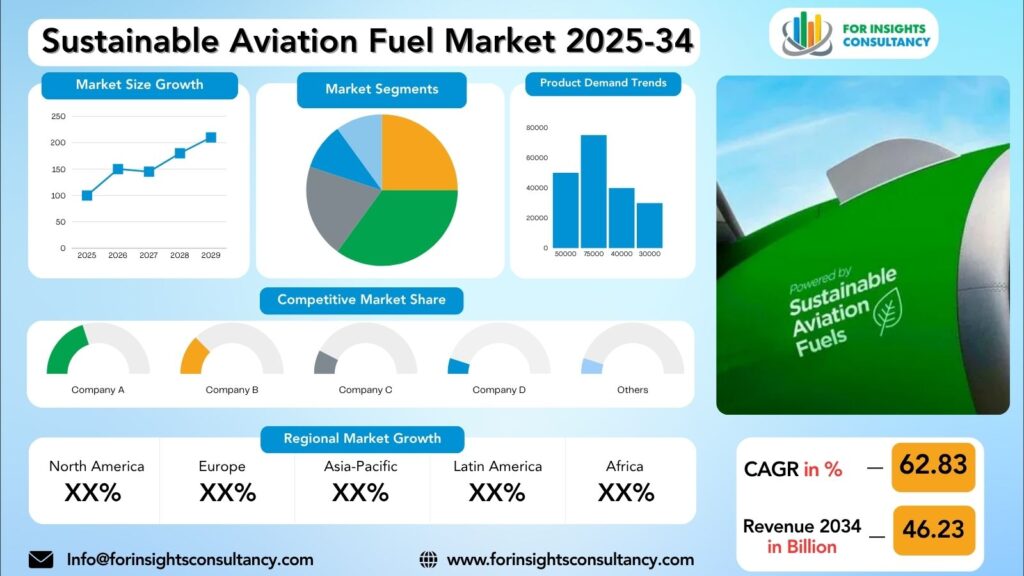
Sustainable Aviation Fuel Market Size, Trends Analysis Research Report By Fuel Type (Biofuel, Power-to-Liquid Fuel, Gas-to-Liquid Fuel, Hydrogen Fuel), by Feedstock (Waste Oils & Fats, Agricultural Residue, Municipal Solid Waste, Others), by Blending Capacity, by Platform, and By Region Global Market Analysis And Forecast, 2025-2034
Oct-2025 Formats | PDF | Category: Manufacturing | Delivery: 24 to 72 Hours
Global revenue from the Sustainable Aviation Fuel market is superior at US$ 2.08 Billion in 2025 and has been up-front to current at a CAGR of 62.83% to reach US$ 46.23 Billion by the end of 2034.
Sustainable Aviation Fuel Market Research Summary
The sustainable aviation fuel industry is evolving and expanding heavily as a result of the heightened eco-consciousness and the implemented regulatory measures aimed at cutting down carbon emissions from the aviation sector. This detailed report investigates the essential factors that impact the sustainable aviation fuel sector, including obstacles and potentialities that lay ahead for it.
Notably, the increased demand for sustainable aviation fuels is largely attributed to the overall pressure programed on the aviation sector to reduce its carbon footprint. Since the use of fossil fuels is still the main source of carbon emissions, the call for eco-friendly fuels, such as biofuels that come from renewable sources, is gaining popularity.
Innovations in the sustainable aviation fuel industry will revolve mostly around making the production process more efficient, finding ways to produce more in less time, and reducing the cost of the product. The willingness of airlines, fuel producers, and government representatives to work together in facilitating the adoption of sustainable aviation fuel is very instrumental in achieving this goal and in the quick market penetration.
Summing up, the sustainable aviation fuel market offers a wide range of possibilities in terms of innovation and partnership which will ultimately lead to a more environmentally friendly and socially responsible aviation industry. The realization and acknowledgment by investors of the significance of financing sustainable aviation fuels for the attainment of climate goals and for making a contribution to a greener future of aviation is rising day by day.
Market Insights
- In 2024, the Sustainable Aviation Fuel Market is projected to see significant growth, with the Asia-Pacific region capturing the largest revenue share and showcasing strong growth prospects.
- The U.S. population residing in urban areas is estimated to be around 83%, indicating a high potential market for sustainable aviation fuel adoption.
- Within the market segments, biofuel is expected to hold the largest revenue share, driven by increasing environmental regulations and the aviation industry’s growing focus on sustainability.
- Overall, the Sustainable Aviation Fuel Market in 2024 is set to witness a robust expansion, with the Asia-Pacific region leading the way in revenue generation and market growth.
Market Dynamics
Trends
Increased Investment: Investments in facilities for the production of sustainable aviation fuel are to be raised significantly, at least in part, due to the attractiveness of the sector to governments and corporations eager to fulfill their sustainability commitments.
Growing Demand: A tremendous increase in the demand for sustainable aviation fuel is to be expected as a result of airlines’ efforts to reduce their carbon emissions and comply with stricter environmental regulations.
Technological Advancements: Production technologies will evolve resulting in more sustainable aviation fuel produced in a more efficient and cost-effective manner.
Collaboration and Partnerships: The number of collaborations among airlines, fuel producers, and regulators aimed at facilitating the adoption of sustainable aviation fuel and thus speeding up its market growth will be increasing.
Expansion of Distribution Networks: Distribution networks will be expanded in order to facilitate access to sustainable aviation fuel and its use will be increased within the aviation industry.
Growth Drivers
Regulatory Support: The demand for sustainable aviation fuel is likely to be driven by increasing regulatory support for cutting carbon emissions in the aviation sector.
Cost Competitiveness: As a result of technological innovations and larger production capacity, sustainable aviation fuel is gradually becoming cost-competitive, thereby creating a demand for it in airlines.
Environmental Awareness: The shift to sustainable aviation fuel is largely driven by the increased awareness of the environmental impact of conventional jet fuels among airlines and passengers.
Investment in Infrastructure: The market growth in the next few years is anticipated due to investments made in new production facilities and distribution networks for sustainable aviation fuel.
Partnerships and Collaborations: The collaboration between airlines, fuel suppliers, and government bodies to encourage the use of sustainable aviation fuel will most probably lead to a faster pace of market extension in 2024-2025.
Restraints
Regulatory challenges: The market growth of sustainable aviation fuel might be hampered by the stringent regulations and policies that are concerned with its production and distribution.
High Production Costs: The high cost of production and refining of a sustainable aviation fuel, in comparison to that of a traditional jet fuel, can be the reason why the market will not expand.
Limited Production Capacity: The volume of renewable aviation fuels that can be produced from the available facilities might be so low that these fuels may become inaccessible to the market, thus limiting their growth potential.
Technological barriers: The requirement for advanced technology and proper facilities both for the production and for the use of sustainable aviation fuel can put a stop to the growth of the market.
Competition from Conventional Energy Sources: The continued use of conventional jet fuels which are cheaper, at least in the short term, can be a reason why the adoption of sustainable aviation fuel in the industry will be slow.
Opportunities
There is a rising need for sustainable aviation fuel due to airlines’ efforts to lower carbon emissions and achieve sustainability goals.
Governments are increasingly supporting and regulating the use of sustainable aviation fuel as a measure to fight climate change.
There is a gradual increase in investment in the research and development of cutting-edge sustainable aviation fuel technologies.
The collaboration opportunities between airlines, fuel producers, and technology companies facilitate the production and the distribution of sustainable aviation fuel to be scaled up.
There are new market trends that, by favoring sustainability and environmental conservation, lead to the use of sustainable aviation fuel in the aviation industry.
Challenges
Regulatory Hurdles: Complying with the stringent regulations on aviation emissions imposed by authorities will be a tough challenge for companies operating in this field.
Cost Competitiveness: The biggest barrier for the large-scale use of sustainable aviation fuels is still to make their price equal to that of traditional jet fuels.
Supply Chain Limitations: The scarcity of raw materials and limited production capacity may result in supply chain disruptions and increase in prices.
Technology Development: It is necessary to keep on research and development activities to sustain production efficiency and volume of sustainable aviation fuels.
Market Acceptance: Getting airlines and consumers to believe in the advantages of sustainable aviation fuels and hence creating the need for them will be the main challenge during the next years.
Sustainable Aviation Fuel Market Top Companies Covered In This Report:
Evaluate The Strategic Positioning And Innovation Pipelines Of Leading Market Companies-From Multinational Enterprises To Disruptive Regional Firms. Understand How Key Players Are Innovating, Expanding, And Capturing Value, And Use Competitive Benchmarks To Plan Your Next Move.
- Neste
- TotalEnergies
- Eni
- OMV Aktiengesellschaft
- World Energy, LLC
Sustainable Aviation Fuel Market Company News 2024 and 2025
Neste Corporation
The company signed a deal to supply Air New Zealand with ~9 million litres (~7,200 tons) of SAF at Los Angeles International Airport in 2024.
TotalEnergies SE
In March 2024 the company and Sinopec signed an agreement to build a SAF facility in China with annual capacity of 230,000 tons
Eni S.p.A
In January 2025 the company’s biorefinery project at Gela (Sicily) began SAF production with capacity of 400,000 tons/year, meeting approx. one-third of Europe’s 2025 SAF demand.
Key Segments
Segmentation By Fuel Type
- Biofuel
- Power-to-Liquid Fuel
- Gas-to-Liquid Fuel
- Hydrogen Fuel
Segmentation By Feedstock
- Liquid
- Powder
- Paste
Segmentation By Feedstock
- Waste Oils & Fats
- Agricultural Residue
- Municipal Solid Waste
- Others
Segmentation By Blending Capacity
- Below 30%
- 30–50%
- Above 50%
Segmentation by Platform
- Commercial Aviation
- Military Aviation
- Unmanned Aerial Vehicles
Global Geographic Coverage:
The Report Provides In-Depth Qualitative And Quantitative Data On The Sustainable Aviation Fuel Market For All Of The Regions And Countries Listed Below:
North America
The Nearshoring Sustainable Aviation Fuel (SAF) industry in North America will be greatly influenced by the region’s economic growth with a GDP increase of 2.3% and inflation of 1.8%. The United States, Canada, and Mexico are the main sub-regions to benefit from this growth.
In the U.S., a single government incentive to promote clean energy is the leading local factor that propels the use of SAF. This subsidy changes consumer behavior in favor of sustainable aviation solutions to a great extent.
How to get SAF is mainly through big airlines and airports in North America and fastest way is by selling directly to eco-friendly companies and individuals. Sustainability and ethical sourcing are basic requirements for consumers in this market, which is indicative of the increasing demand for environmentally friendly products.
The developing economies of Central America and the Caribbean, where price and status still largely influence consumer decisions, thus slowly transitioning to sustainable alternatives, are examples of such markets.
Europe
The demand in the European sustainable aviation fuel market is largely influenced by the projected GDP growth and inflation rates. Various sub-regions within Europe reveal different market drivers due to which their demand patterns differ. Take France for example, where the defrayment of the French government for sustainable aviation fuels has been the prominent factor in the extensive adoption and growth of the same. These products are mainly sold through the establishments of partnerships with airlines and fuel suppliers, whereas online sales are the fastest developing channel.
Consumers in Europe are getting more and more concerned about sustainability and ethical sourcing, hence, making these aspects essential in their purchasing decisions. In numerous emerging markets where price and status are the main factors, there is a considerable potential for raising the awareness of consumers about the advantages of sustainable aviation fuels and consequently, increasing the penetration of such fuels through properly designed marketing campaigns.
Asia Pacific
The Sustainable Aviation Fuel market in Asia Pacific is expected to experience a significant expand which will be majorly influenced by the region’s rapidly rising GDP and inflation rate. Japan’s government subsidy for biofuel research is a major factor that attracts other elements and a cultural push towards sustainability A major channel for sustainable aviation fuel in Japan is through collaborations with airlines, while the fastest-growing channel is direct sales to corporations with sustainability goals. Consumers in South Korea are focused on ethical sourcing, which is a compulsory feature for companies operating in the market. In the case of Indonesia, an emerging market, price and status are still the major factors that influence the consumers but a shift towards sustainability is starting to become evident.
Middle East and Africa
The Middle East and Africa sustainable aviation fuel market is expected to be positively influenced by the region’s strong commitment to sustainability. The market looks attractive with a predicted GDP growth rate of 4.5% and an inflation rate of 2.3%.
Morroco is one of the countries where the government subsidy towards sustainable aviation fuels has become a powerful driver for the sector by creating incentives for companies to invest in environmentally friendly alternatives. The primary channel for SAF distribution in the region is through partnerships with airlines and airport authorities, whereas the fastest-growing channel is direct sales to corporate clients.
Customers in this region are highly concerned about the environment and the ethical origin of the products, which is why these are the factors that companies willing to operate in the market must take into consideration. However, in numerous emerging markets where price and status are more important, companies need to strike a balance between providing sustainable options and satisfying consumers’ demand for affordable products.
Frequently Asking Questions
What is the Sustainable Aviation Fuel market size and growth forecast?
Sustainable Aviation Fuel Market is predicted to grow from USD 2.08 Billion in 2025 to approximately USD 46.23 Billion by 2034. the industry is estimated to expand at a CAGR of 62.83%.
Who are the key players in the Sustainable Aviation Fuel market?
The Sustainable Aviation Fuel Market Includes Major Companies Neste, TotalEnergies, Eni, OMV Aktiengesellschaft, World Energy, LLC, Others.
What are the current and future trends for Sustainable Aviation Fuel market?
The Sustainable Aviation Fuel market is experiencing a notable growth driven by increasing environmental concerns and government regulations promoting sustainable practices. Future trends indicate a significant surge in demand for alternative aviation fuels as airlines and stakeholders prioritize reducing carbon emissions in the aviation sector.
What are the challenges facing the Sustainable Aviation Fuel market?
The challenges facing the Sustainable Aviation Fuel market include high production costs and limited availability of feedstocks. Additionally, the need for large scale infrastructure investments and regulatory support poses obstacles to market growth.
Which regions dominate the Sustainable Aviation Fuel market?
North America and Europe currently dominate the Sustainable Aviation Fuel market, driven by increasing environmental regulations, government incentives, and growing awareness about reducing carbon emissions in the aviation industry.
Report Features
This report gives the most complete information. The report on Sustainable Aviation Fuel Market format has been designed so that it can provide the best value to the business. It offers crucial insights into the market’s dynamic and will aid in strategic decision-making for current players as well as those looking to join the market.
What Deliverables Will You Get in this Report?
|
Key questions this report answers |
Relevant contents in the report |
|
How big is the sales opportunity? |
In-depth analysis of the Global Sustainable
Aviation Fuel Market |
|
How lucrative is the future? |
Market forecast and trend data and emerging
trends |
|
Which regions offer the best sales opportunities? |
Global, regional and country level historical
data and forecasts |
|
Which are the most attractive Sustainable
Aviation Fuel market Key segments? |
Market segment analysis and |
|
Which are the top Key players and Their
Sustainable Aviation Fuel market positioning? |
Competitive landscape analysis, Market share
analysis |
|
How complex is the business environment? |
Porter’s five forces analysis, PEST analysis,
Life cycle analysis |
|
What are the factors affecting the Sustainable
Aviation Fuel market? |
Drivers & Restraints |
|
Will I get the information on my |
Customized Report as per your Business
Needs Our analysts will work directly with you and
understand your needs Get data on specified regions or segments,
competitor and Vendors Data will be formatted and presented as per your
requirements Any Requirement Contact Us: Https://Www.Forinsightsconsultancy.Com/Contact-Us |
Table of Contents
For TOC Contact us: https://forinsightsconsultancy.com/contact-us/






